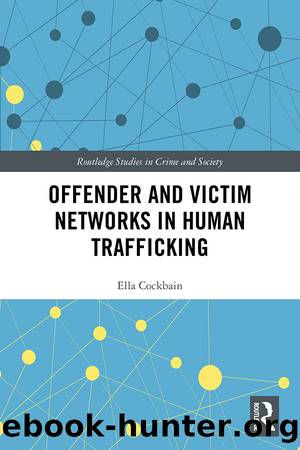Offender and Victim Networks in Human Trafficking by Ella Cockbain

Author:Ella Cockbain [Cockbain, Ella]
Language: eng
Format: epub
Tags: Social Science, General, Criminology
ISBN: 9781317241430
Google: pXNgDwAAQBAJ
Publisher: Routledge
Published: 2018-08-06T04:45:18+00:00
Introducing a new model of grooming
At the start of the chapter I outlined how dominant conceptions of grooming can be modelled. By now, it should be clear that none of those models adequately and accurately reflect the realities of grooming in these internal child sex trafficking networks. While the offenderâvictim dyad is certainly not irrelevant in this context, it needs to be situated within a more complex system of social interchange. I did this by consolidating my results into the conceptual model shown in Figure 4.3.
The model is an abstraction that conceptualises possible grooming interactions between and within offender and victim networks. It is illustrative rather than deterministic: a given instance may not involve all theoretically possible exchanges. For clarityâs sake, I used a simple two-by-two model but in reality there may be more or fewer people involved. It is also worth stressing that although this is a simple unweighted model, in reality components are likely to vary in their influence especially given the inherent power imbalance between victims and offenders. I now discuss each main part of the model in turn. Please note that in addition to the direct pathways discussed here, there can also be indirect pathways through the model, for example if an offender uses a victim to coerce a second victim into sex.
First, the arrows looping in and out of the offender and victim symbols represent the way that both parties can both engage in what is effectively self-grooming, in that it helps normalise and legitimise the abuse. The idea of offender self-grooming builds on Craven et al.âs (2006) work; victim self-grooming is an analogous but novel construct. There was notable evidence to suggest that both victims and offenders engaged in processes such as cognitive restructuring, minimising the harm of the trafficking and blaming and/or dehumanising victims (this latter applies particularly to offenders but also to some victimsâ attitudes to other victims). The resignation of some of the most extensively abused victims to offendersâ demands may also represent a type of learned helplessness (Zimbardo, 2007).
Figure 4.3 Model of grooming involving multiple offenders and multiple victims.
Download
This site does not store any files on its server. We only index and link to content provided by other sites. Please contact the content providers to delete copyright contents if any and email us, we'll remove relevant links or contents immediately.
The 1921 Tulsa Race Massacre by Chris M. Messer(286)
Introduction to Criminal Justice - A Balanced Approach by Brian K. Payne Willard M. Oliver Nancy E. Marion(254)
Punishing the Poor The Neoliberal Government of Social Insecurity by Unknown(249)
Russia's Sakhalin Penal Colony, 1849â1917 by Andrew A. Gentes(248)
The History of Newgate Prison by Jowett Caroline;(235)
Serial Killers America and UK - 2 BOOKS IN 1 by Clark Matthew(210)
A History of Police and Masculinities, 1700-2010 by David G. Barrie Susan Broomhall(195)
Restorative Justice in Transitional Settings by Kerry Clamp(168)
Organized Crime and Corruption Across Borders by T. Wing Lo Dina Siegel Sharon I Kwok(158)
Culture, Crime and Punishment by Ronald Kramer(155)
Cops, Cameras, and Crisis by Michael D. White Aili Malm(154)
Dangerousness, Risk and the Governance of Serious Sexual and Violent Offenders by Karen Harrison(153)
Policing Gender, Class And Family In Britain, 1800-1945 by Linda Mahood(152)
Routledge Handbook on Immigration and Crime by Holly Ventura Miller Anthony Peguero(151)
The Real CSI by Kate Bendelow(149)
Women Exiting Prison by Bree Carlton Marie Segrave(142)
Losing Legitimacy by Gary Lafree(138)
Using Murder by Philip Jenkins(136)
A Theory of African American Offending by James D. Unnever Shaun L. Gabbidon(134)
